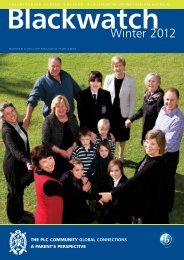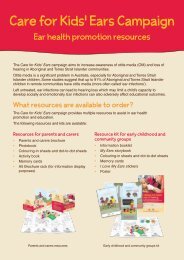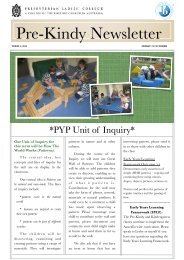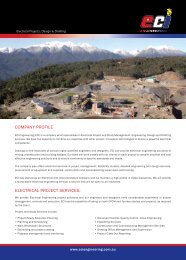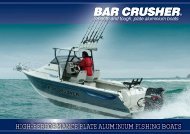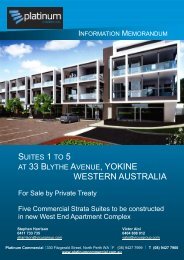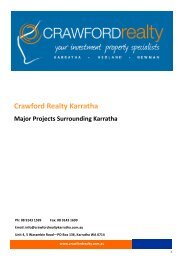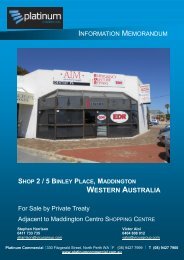Port Hedland Australia's iron ore boom town - Aussiehome
Port Hedland Australia's iron ore boom town - Aussiehome
Port Hedland Australia's iron ore boom town - Aussiehome
You also want an ePaper? Increase the reach of your titles
YUMPU automatically turns print PDFs into web optimized ePapers that Google loves.
Hot spot | port hedland<br />
Chart 4: 10-year average annual house price growth<br />
20.0%<br />
18.0%<br />
16.0%<br />
14.0%<br />
12.0%<br />
10.0%<br />
8.0%<br />
6.0%<br />
4.0%<br />
2.0%<br />
18.0%<br />
0.0%<br />
<strong>Port</strong><br />
<strong>Hedland</strong><br />
Source: RP Data, Residex<br />
Chart 5: Gross rental yields<br />
10.0%<br />
9.0%<br />
8.0%<br />
7.0%<br />
6.0%<br />
5.0%<br />
4.0%<br />
3.0%<br />
2.0%<br />
1.0%<br />
0.0%<br />
10.0%<br />
<strong>Port</strong><br />
<strong>Hedland</strong><br />
Source: RP Data (as at June 2010)<br />
12.2%<br />
11.3%<br />
(eg, apartment complexes and schools)<br />
projects underway.<br />
With ANZ f<strong>ore</strong>casting China’s<br />
growth to continue to remain at<br />
approximately 9% for the next 10 years,<br />
the future demand for Australian <strong>iron</strong><br />
<strong>ore</strong> and other commodities is assured.<br />
The <strong>Port</strong> <strong>Hedland</strong> <strong>boom</strong><br />
The property market of <strong>Port</strong> <strong>Hedland</strong> –<br />
comprised of the twin regions<br />
South <strong>Hedland</strong> (inland) and <strong>Port</strong><br />
<strong>Hedland</strong> (coast) – has undergone an<br />
amazing <strong>boom</strong>.<br />
The <strong>town</strong> has long experienced<br />
sustained and strong capital growth<br />
(see Chart 3), with median house<br />
values rising from $66,000 to $184,000<br />
over the 10 years to 2000. Over the<br />
following five years, values doubled to<br />
$361,000. The current average price for<br />
9.9%<br />
9.5%<br />
6.6%<br />
Perth Brisbane National Melbourne Sydney<br />
3.9%<br />
Perth –<br />
houses<br />
4.2% 4.0%<br />
Perth –<br />
units<br />
National –<br />
houses<br />
4.8%<br />
National –<br />
units<br />
<strong>Port</strong> <strong>Hedland</strong> and South <strong>Hedland</strong> sits<br />
at $740,000.<br />
While the median house prices<br />
have grown nationally at a 10-<br />
year average annual growth rate of<br />
9.9% (12.2% and 11.3% for the<br />
commodities <strong>boom</strong> capitals of Perth<br />
and Brisbane respectively), this pales<br />
in comparison to returns investors<br />
have made by directly investing in<br />
<strong>Port</strong> <strong>Hedland</strong>.<br />
Specifically, median house values for<br />
<strong>Port</strong> <strong>Hedland</strong> have risen at double the<br />
national 10-year average annual growth<br />
rate – a stellar 18%.<br />
The reasons for this phenomenal<br />
<strong>boom</strong> in prices come down to the influx<br />
of thousands of very well-paid miners<br />
and the <strong>town</strong>’s severe land supply<br />
constraints, which have seen years of<br />
zero or near zero vacancy levels.<br />
Rental yields are a staggering 10%<br />
– easily the highest in Australia (see<br />
Chart 5) – and have been at these levels<br />
for many, many years as the <strong>town</strong> has<br />
struggled to cope with the influx of<br />
workers associated with the numerous<br />
<strong>iron</strong> <strong>ore</strong> projects in the Pilbara region.<br />
Consequently, at the start of the<br />
commodities <strong>boom</strong>, astute investors<br />
seeking the likely huge demand for <strong>iron</strong><br />
<strong>ore</strong> by China snapped up four-bedroom<br />
homes in <strong>town</strong> for between $210,000<br />
and $240,000 in 2002 and 2003.<br />
Seven years later, these homes now<br />
fetch between $950,000 and $1.2m, with<br />
rents of $1,200 per week for a $600,000<br />
property in South <strong>Hedland</strong> and $2,000<br />
per week for $950,000 homes in <strong>Port</strong><br />
<strong>Hedland</strong>.<br />
Mines and land supply constraints<br />
<strong>Port</strong> <strong>Hedland</strong> had been a remote outpost<br />
on Australia’s north-west coast, 1,700km<br />
from Perth. This has all changed in the<br />
last 10 years.<br />
The expansion and opening of over<br />
20 mines in the Pilbara region have<br />
dramatically altered the <strong>town</strong>’s property<br />
market, which is essentially land-locked<br />
by expansive flood plains.<br />
The sudden transformation of<br />
<strong>Port</strong> <strong>Hedland</strong> into Australia’s largest<br />
exporting port by tonnage, and resultant<br />
large wage increases combined with the<br />
<strong>town</strong>’s unique land supply constraints,<br />
have made a perfect recipe for its<br />
property <strong>boom</strong>.<br />
Further, the dramatic rise in ‘fly in/<br />
fly out’ (FIFO) workers from Perth<br />
and interstate into <strong>Port</strong> <strong>Hedland</strong> means<br />
FIFO workers now account for some<br />
2,000 (11%) of the <strong>town</strong>’s population.<br />
As Australia enters the second leg of<br />
the commodities <strong>boom</strong>, these powerful<br />
forces will continue to exert strong<br />
upwards pressure on <strong>Port</strong> <strong>Hedland</strong>’s<br />
rents and property prices.<br />
Miners and their $100,000 salaries<br />
The mining <strong>boom</strong> has rapidly boosted<br />
the <strong>town</strong>’s average salary for workers,<br />
which has risen 39% within seven years<br />
from $43,000 to $60,000 in 2007 – the<br />
latest data available from the Australian<br />
Bureau of Statistics – and has most likely<br />
continued to rise over the last two years.<br />
This rapid rise is due to the fact that<br />
virtually every worker employed by<br />
BHP Billiton and Fortescue Metals<br />
Group (which export <strong>iron</strong> <strong>ore</strong> out of<br />
20 www.yipmag.com.au





